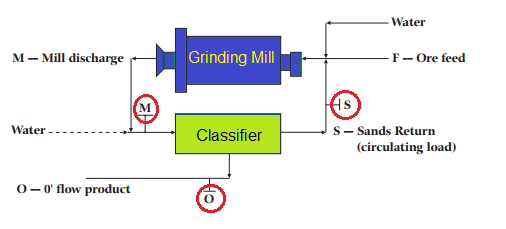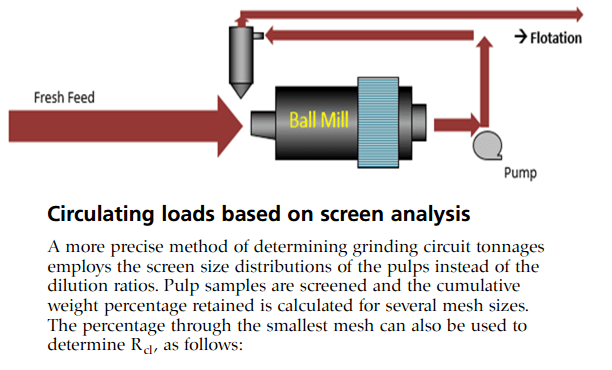Table of Contents
Calculating a grinding circuit’s circulating loads based on Screen Analysis of its slurries. Compared to %Solids or Density based Circulating load equations, a more precise method of determining grinding circuit tonnages uses the screen size distributions of the pulps instead of the dilution ratios. Pulp samples collected around the ball mill or rod mill and hydrocyclones, screen or classifier (classification system) are screened and the cumulative weight percentage retained is calculated for several mesh sizes to obtain the Ball Mill Circulating Load.

The percentage through the smallest mesh can also be used to determine Rcl, as follows:
The same as circulating load using pulp densities where the screen analyses of the three samples are as follows.
Why have a large circulation load:
Cytec Handbook

Arthur Taggart
Circulating Load Versus Grinding Mill Throughput
Although the functions of the classifying device and the mill in a grinding circuit are quite different, the performance of each is interrelated and should be viewed as a single unit operation. The performance of the mill is influenced by the quantity and quality of the circulating load being returned to the mill. The performance of the cyclone is influenced by the particle size distribution of the mill discharge. The net result of the unit operation is a reduction in size of the new feed tonnage from a prescribed top size to a desired product size.
It is the above interrelationship that governs both the capacity of the grinding circuit and the desired grind. The capacity of the grinding circuit is dictated by the number of tons of feed coarser than the desired product size that the mill is capable of grinding finer than the desired product size. A the mill produces a diminishing percentage of finished material as the new feed rate increases. To maintain the same product distribution, the coarser mill discharge requires a larger circulating load to return the coarse fraction back to the mill. Therefore, to increase circuit capacity or produce a finer grind, higher circulating loads are required.
As the circulating load increases, typically the cyclone underflow density increases, causing the density and viscosity in the mill to also increase. This can lead to excessive mill viscosity, causing the balls to float, leading to a sharp drop in the power draw. The operator can be misled to conclude that the mill is overloaded due to the higher circulating load. The operator will usually sharply reduce the feed rate, when actually an increase in dilution water at the feed end of the mill will lower the mill viscosity and allow operation at the higher circulating load.
As the circulating load increases to higher levels, it is also not uncommon for the pump or the cyclone to become the capacity bottleneck due to volume constraints. These volume constraints are not always readily apparent, leading to the assumption that the increased circulating load has limited the ball mill capacity. Therefore, changes to the pump and cyclone may be required to handle the higher circulating load caused by an increased new feed rate.
Over Grinding
The circulating loads generated in a typical ball mill cyclone circuit contain a small fraction of bypassed fines. The concept that high circulating loads will result in overgrinding can be refuted by regarding increases in circulating load in the same vein as multistage grinding. That is, for every incremental increase in circulating load of 100%, an additional stage of grinding and classification occurs. With high circulating loads, the particle size reduction per pass is proportionately less and the generation of slimes considerably less than with low circulating loads or open circuit grinding. This is due to the lower residence time per pass.
In a properly designed circuit, each finely ground particle of the required product size has ample opportunity to exit the grinding circuit after each pass through the mill. As a result, few -10 micron fines are generated in the grinding circuit. The presence of these fines are likely attributed to the inherent fines in the new mill feed.


